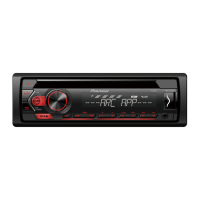
Do you have a question about the Pioneer DEH-S120UB and is the answer not in the manual?
| Channels | 4 |
|---|---|
| Tuner | AM/FM |
| USB Port | Yes |
| Bluetooth | No |
| CD Player | Yes |
| Display Type | LCD |
| AUX Input | Yes |
| MP3 Playback | Yes |
| WMA Playback | Yes |
| FLAC Playback | No |
| Detachable Face | Yes |
| Remote Control | No |
| Preset EQ | Yes |
| High-Pass Filter | Yes |
| Low-Pass Filter | Yes |
| DIN Size | 1 DIN |
| Max Power Output | 50W x 4 Channels |
| RMS Power Output | 22W x 4 Channels |
Explains the physical layout and controls of the head unit.
Describes the remote control functions and notes its availability.
Describes common actions like power, volume, source selection, display changes, and bass boost.
Explains the meaning of various icons shown on the unit's display.
Provides crucial advice regarding front panel care and storage.
Details how to replace the battery in the remote control.
Covers WEEE directive and proper disposal methods for electronics and batteries in the EU.
Advises contacting local authorities for disposal outside the EU.
Warns about ingestion, child safety, and heat exposure for batteries.
Cautions regarding incorrect battery replacement and handling.
Guides through the initial setup steps like language and clock settings.
Explains how to disable the demonstration mode.
Details options like FM STEP, SP-P/O MODE, S/W UPDATE, and SYSTEM RESET.
Explains frequency allocation and RDS functionality for radio reception.
Describes how to tune into pre-stored radio stations.
Explains the automatic storage of the six strongest stations.
Describes how to manually scan for radio stations.
Explains how to manually save a station.
Details how to search for stations based on program type.
Instructions for inserting and ejecting CDs.
Guides on connecting USB devices and notes for automatic switching.
Refers to details on AOA connection on another page.
Information about MTP connection for Android devices and compatibility.
Instructions for connecting and selecting the AUX source.
Details operations for selecting tracks, fast forward/reverse, search, repeat, random, and pause.
Explains how to operate the unit via the Pioneer ARC APP.
Specifies requirements for Android devices.
Steps to connect the unit to an Android device for app control.
Outlines controls for track selection, fast forward/reverse, pause, and sound retriever.
Explains how to enter and browse the main settings categories.
Describes FM SETTING for sound quality.
Groups BSM, REGIONAL, LOCAL, TA, AF, NEWS, SEEK options.
Covers S.RTRV, FADER, BALANCE, EQ SETTING, LOUDNESS.
Details SUB.W, SUB.W CTRL, and BASS BOOST settings.
Includes LANGUAGE, CLOCK SET, 12H/24H, SCROLL SET, AUTO PI, AUX, MUTE MODE.
Covers DIM SETTING and BRIGHTNESS.
Explains the PW SAVE feature.
Details MEMORY vs APP CONTROL.
Describes enabling automatic app launch.
Explains automatic switching to USB source.
Lists display, repeat range, subfolder, and intermittent sound problems.
Explains common error codes and their resolutions.
Details errors like FORMAT READ, NO AUDIO, SKIPPED, PROTECT, N/A USB, HUB ERROR, CHECK USB, ERROR-19, ERROR-23.
Provides advice on using compatible discs and player handling.
Discusses file name length, WMA encoding, and Russian text display.
Details WMA file extension, bit rate, and sampling frequency.
Notes on USB hubs, securing devices, and potential issues.
Lists MP3 file extension, bit rate, sampling frequency, ID3 tag version, and playlist compatibility.
Details WAV file extension, quantization bits, and sampling frequency.
Mentions FLAC file extension and sampling frequency.
Covers folder hierarchy, playable folders/files, playback of copyright-protected files, and partitioned USB devices.
Explains how file sequence depends on the connected device and hidden files.
Illustrates folder hierarchy and playback sequence numbering.
Provides a chart for Russian characters.
Details WMA usage and licensing from Microsoft.
Covers FLAC copyright and redistribution terms.
Lists power source, grounding, current consumption, dimensions, and weight.
Details maximum and continuous power output, load impedance, preout level, loudness, and equalizer.
Covers system, usable discs, signal-to-noise ratio, channels, and decoding formats.
Details USB standard, current supply, protocols, file systems, and decoding formats.
Lists frequency range, usable sensitivity, and signal-to-noise ratio.
Frequency range, usable sensitivity, and signal-to-noise ratio.
Frequency range, usable sensitivity, and signal-to-noise ratio.

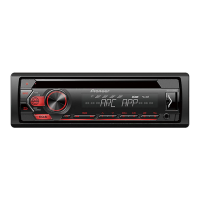
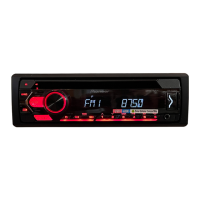
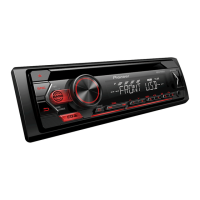
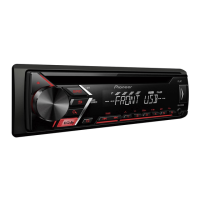
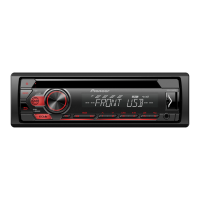






